tire type CHEVROLET CAMARO 1998 4.G Owners Manual
[x] Cancel search | Manufacturer: CHEVROLET, Model Year: 1998, Model line: CAMARO, Model: CHEVROLET CAMARO 1998 4.GPages: 402, PDF Size: 21.2 MB
Page 194 of 402
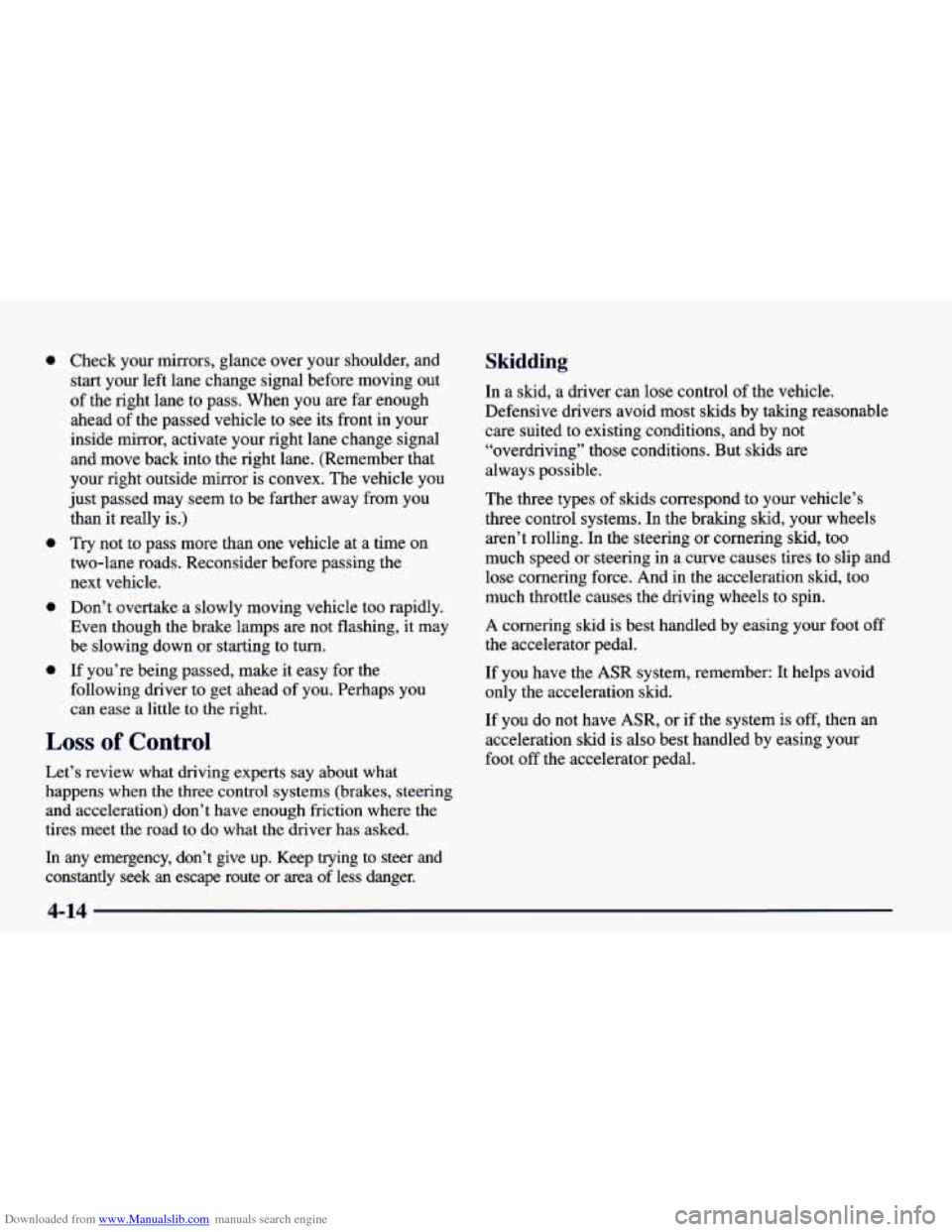
Downloaded from www.Manualslib.com manuals search engine 0 Check your mirrors, glance over your shoulder, and
start your left lane change signal before moving out
of the right lane to pass. When you are far enough
ahead
of the passed vehicle to see its front in your
inside mirror, activate your right lane change signal
and move back into the right lane. (Remember that
your right outside mirror is convex. The vehicle you
just passed may seem to be farther away from you
than
it really is.)
0 Try not to pass more than one vehicle at a time on
two-lane roads. Reconsider before passing the
next vehicle.
0 Don’t overtake a slowly moving vehicle too rapidly.
Even though the brake lamps
are not flashing, it may
be slowing down or starting to turn.
following driver to get ahead of you. Perhaps you
can ease a little to the right.
0 If you’re being passed, make it easy for the
Loss of Control
Let’s review what driving experts say about what
happens when the three control systems (brakes, steering
and acceleration)
don’t have enough friction where the
tires meet the road to do what the driver has asked.
Skidding
In a skid, a driver can lose control of the vehicle.
Defensive drivers avoid most skids by taking reasonable
care suited to existing conditions, and by not
“overdriving” those conditions. But skids
are
always possible.
The three types of
skids correspond to your vehicle’s
three control systems. In the braking skid, your wheels
aren’t rolling. In the steering or cornering skid, too
much speed or steering in a curve causes tires to
slip and
lose cornering force. And
in the acceleration skid, too
much throttle causes the driving wheels to spin.
A cornering skid is best handled by easing your foot off
the accelerator pedal.
If you have the ASR system, remember: It helps avoid
only the acceleration
skid.
If you do not have ASR, or if the system is off, then an
acceleration skid is also best handled by easing your
foot
off the accelerator pedal.
In any emergency, don’t give up. Keep trying to steer and
constantly seek an escape route or area
of less danger.
Page 213 of 402
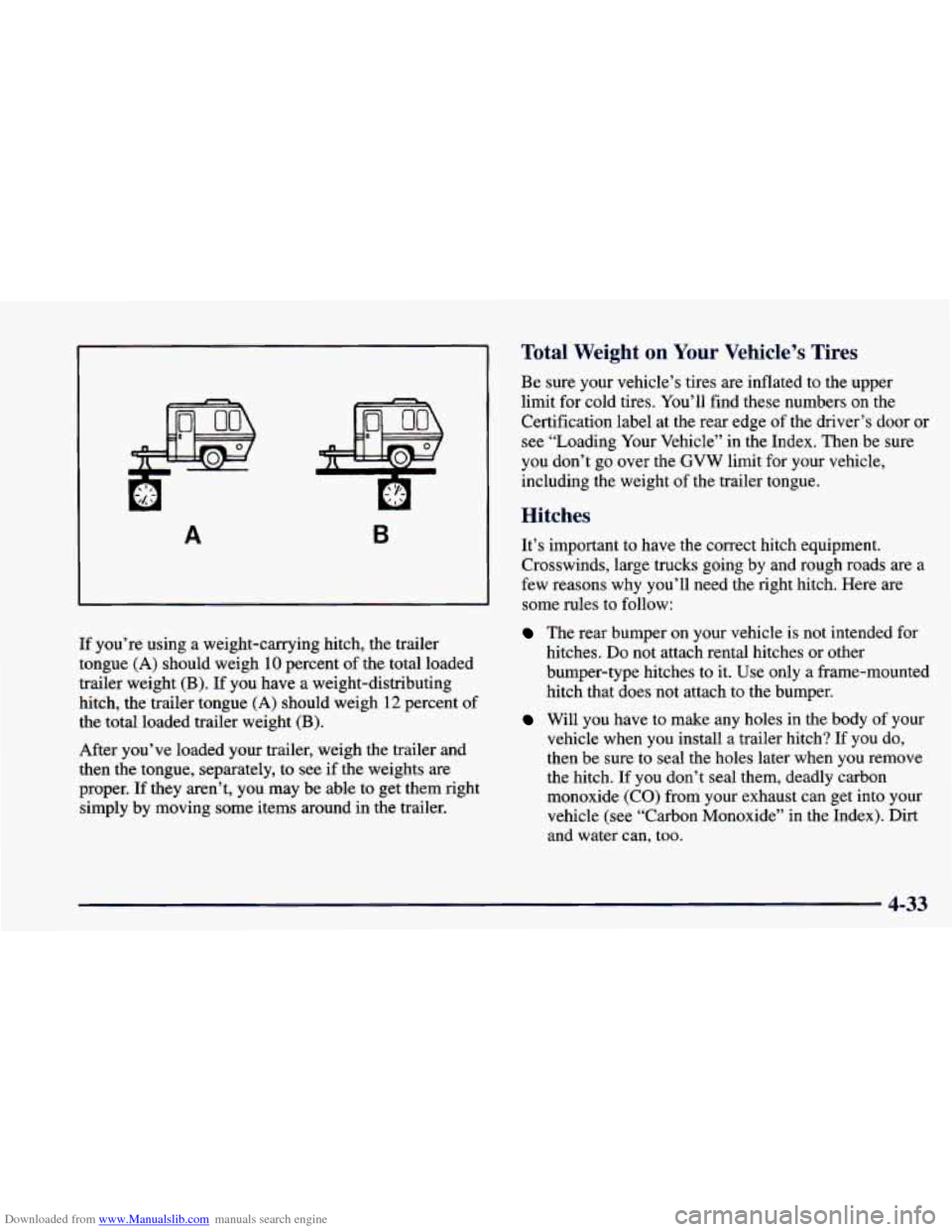
Downloaded from www.Manualslib.com manuals search engine A B
If you’re using a weight-carrying hitch, the trailer
tongue
(A) should weigh 10 percent of the total loaded
trailer weight
(B). If you have a weight-distributing
hitch, the trailer tongue
(A) should weigh 12 percent of
the total loaded trailer weight (B).
After you’ve loaded your trailer, weigh the trailer and
then the tongue, separately, to see
if the weights are
proper.
If they aren’t, you may be able to get them right
simply by moving some items around in the trailer.
Total Weight on Your Vehicle’s Tires
Be sure your vehicle’s tires are inflated to the upper
limit for cold tires. You’ll find these numbers on the
Certification label at the rear edge of the driver’s door or
see “Loading Your Vehicle” in the Index. Then be sure
you don’t go over the GVW limit for your vehicle,
including the weight of the trailer tongue.
Hitches
It’s important to have the correct hitch equipment.
Crosswinds, large trucks going by and rough roads are a
few reasons why you’ll need the right hitch. Here are
some rules to follow:
The rear bumper on your vehicle is not intended for
hitches. Do not attach rental hitches or other
bumper-type hitches to it. Use only a frame-mounted
hitch that does not attach to the bumper.
Will you have to make any holes in the body of your
vehicle when
you install a trailer hitch? If you do,
then be sure to seal the holes later when you remove
the hitch. If you don’t seal them, deadly carbon
monoxide (CO) from your exhaust can get into your
vehicle (see “Carbon Monoxide” in the Index). Dirt
and water can, too.
4-33
Page 225 of 402
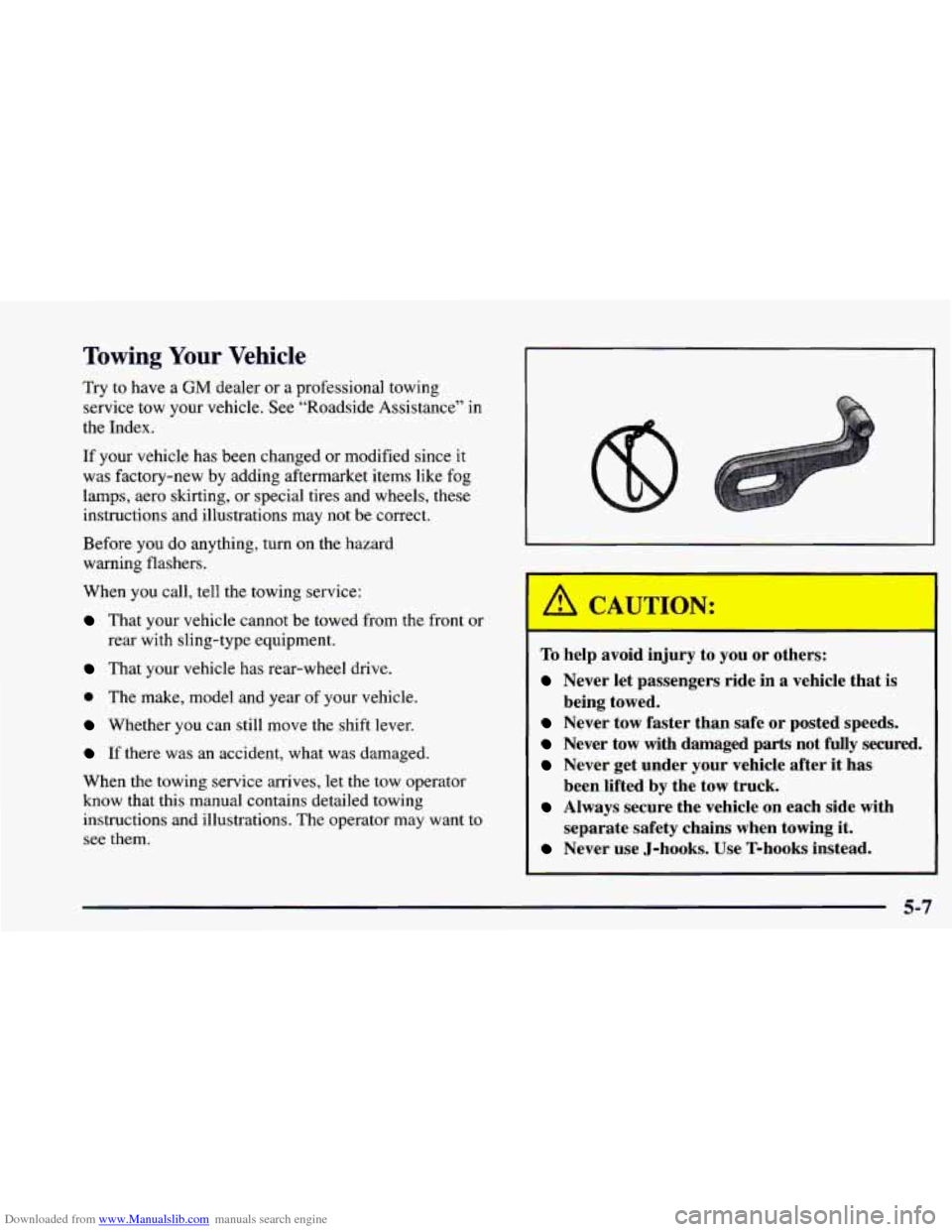
Downloaded from www.Manualslib.com manuals search engine Towing Your Vehicle
Try to have a GM dealer or a professional towing
service tow your vehicle. See “Roadside Assistance’’
in
the Index.
If your vehicle has been changed
or modified since it
was factory-new by adding aftermarket items like fog
lamps, aero skirting, or special tires and wheels, these
instructions and illustrations may not be correct.
Before you do anything, turn
on the hazard
warning flashers.
When
you call, tell the towing service:
That your vehicle cannot be towed from the front or
rear with sling-type equipment.
That your vehicle has rear-wheel drive.
0 The make, model and year of your vehicle.
Whether you can still move the shift lever.
If there was an accident, what was damaged.
When the towing service arrives, let the tow operator
know that this manual contains detailed towing
instructions and illustrations. The operator may want to
see them.
1
t To help avoid injury to you or o
Never let passengers ride in a vehicle that is
Never tow faster than safe or posted speeds.
Never tow with damaged parts not fully secured.
Never get under your vehicle after it has
been lifted
by the tow truck.
Always secure the vehicle on each side with
separate safety chains when towing
it.
Never use J-hooks. Use T-hooks instead.
being towed.
5-7
Page 303 of 402

Downloaded from www.Manualslib.com manuals search engine When to Check
Check your tires once a month or more.
Don’t forget your compact spare tire. It should be
at
60 psi (420 kPa).
How to Check
Use a good quality pocket-type gage to check tire
pressure. You can’t tell if your tires are properly inflated
simply by lookrng at them. Radial tires may look
properly inflated even when they’re underinflated.
Be sure to put the valve caps back on the valve
stems. They help prevent leaks by keeping out dirt
and moisture.
Tire Inspection and Rotation
Tires should be rotated every 6,000 to 8,000 miles
(10
000 to 13 000 km). Any time you notice unusual
wear, rotate your tires as soon as possible and check
wheel alignment. Also check for damaged tires or
wheels. See “When It’s Time for New Tires” and
“Wheel Replacement” later in this section for
more information. The
purpose of regular rotation is to achieve more
uniform wear
for all tires on the vehicle. The first
rotation is the
most important. See “Scheduled
Maintenance Services” in the Index for scheduled
rotation intervals.
LA
If you don’t have P245/5OZR16 Goodyear Eagle GS-C
tires or P275/4OZR17 Goodyear Eagle F1-GS tires, use
the rotation pattern shown above for your tires.
6-45
Page 305 of 402

Downloaded from www.Manualslib.com manuals search engine When It’s Time for New Tires
One way to tell when it’s
time for
new tires is to
check the treadwear
indicators, which will
appear when your tires have
only
1/16 inch (1.6 mm) or
less of tread remaining.
You need
a new tire if any of the following statements
are true:
YOU can see the indicators at three or more places
around the tire.
You can see cord or fabric showing through the
tire’s rubber.
The tread or sidewall is cracked, cut or snagged deep
enough
to show cord or fabric.
The tire has a bump, bulge or split.
The tire has a puncture, cut or other damage that
can’t be repaired well because of the size or location
of the damage.
Buying New Tires
To find out what kind and size of tires you need, look at
the Tire-Loading Information label.
The tires installed on your vehicle when it was new had
a Tire Performance Criteria Specification (TPC Spec)
number on each tire’s sidewall. When you get new tires,
get ones with that same TPC Spec number. That way
your vehicle will continue to have tires that are designed
to give proper endurance, handling, speed rating, traction, ride and other things during normal service on
your vehicle.
If your tires have an all-season tread
design, the TPC number will be followed by an
“MS”
(for mud and snow).
If you ever replace your tires with those not having a
TPC Spec number, make sure they are the same size,
load range, speed rating and construction type (bias,
bias-belted or radial) as your original tires.
6-47
Page 306 of 402
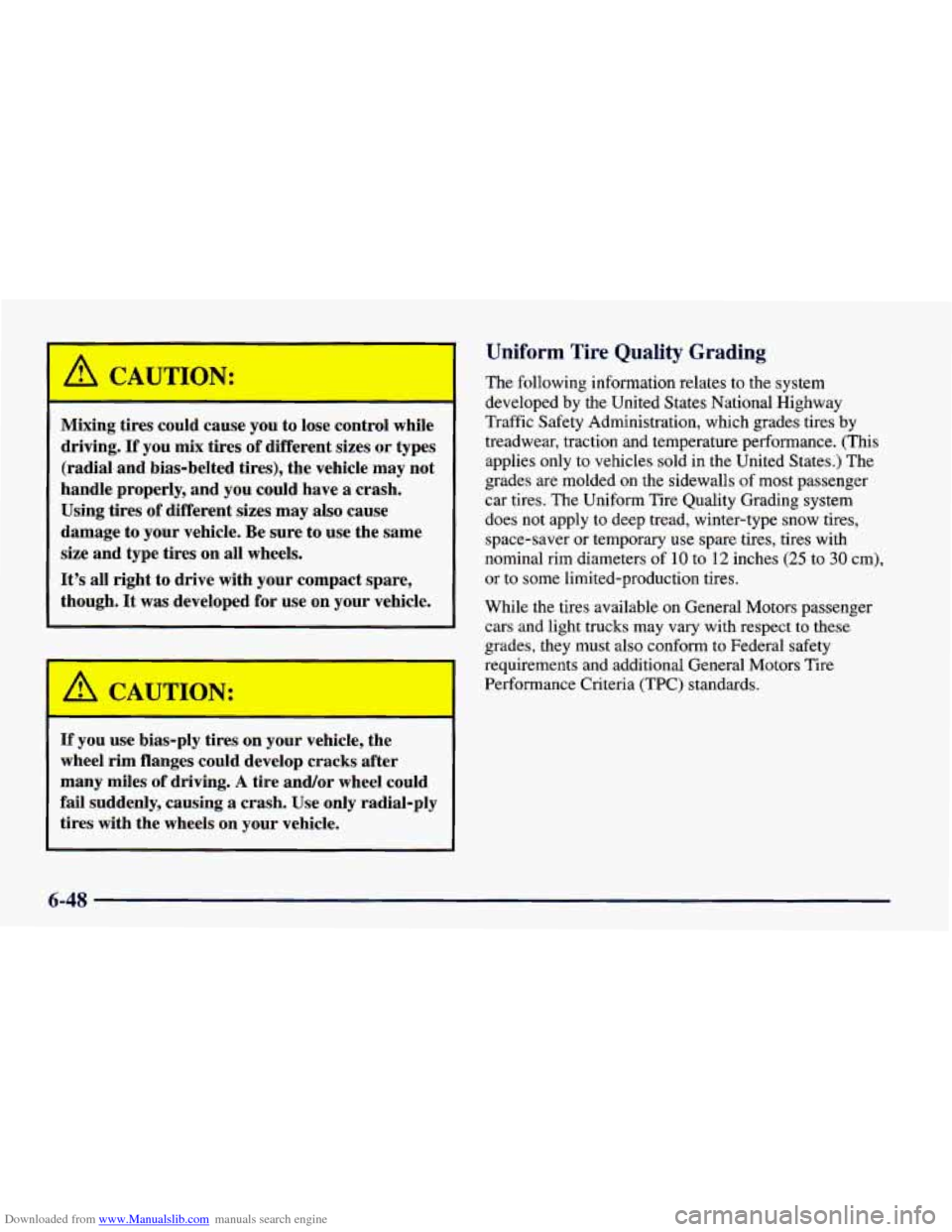
Downloaded from www.Manualslib.com manuals search engine Mixing tires could cause you to lose control while
driving.
If you mix tires of different sizes or types
(radial and bias-belted tires), the vehicle may not
handle properly, and you could have a crash.
Using tires of different sizes may also cause
damage to your vehicle. Be sure
to use the same
size and type tires
on all wheels.
It's all right to drive with your compact spare,
though.
It was developed for use on your vehicle.
If you use bic 'ply tires on your vehicle, the
wheel rim flanges could develop cracks after
many miles
of driving. A tire and/or wheel could
fail suddenly, causing
a crash. Use only radial-ply
tires with the wheels
on your vehicle.
Uniform '--I Quality Grading
The following information relates to the system
developed
by the United States National Highway
Traffic Safety Administration, which grades tires
by
treadwear, traction and temperature performance. (This
applies only to vehicles sold in the United States.) The
grades are molded on the sidewalls
of most passenger
car tires. The Uniform Tire Quality Grading system
does not apply to deep tread, winter-type snow tires,
space-saver or temporary use spare tires, tires with
nominal rim diameters of
10 to 12 inches (25 to 30 cm),
or to some limited-production tires.
While the tires available on General Motors passenger
cars and light trucks
may vary with respect to these
grades, they must also conform to Federal safety
requirements and additional General Motors Tire
Performance Criteria (TPC) standards.
6-48
Page 309 of 402
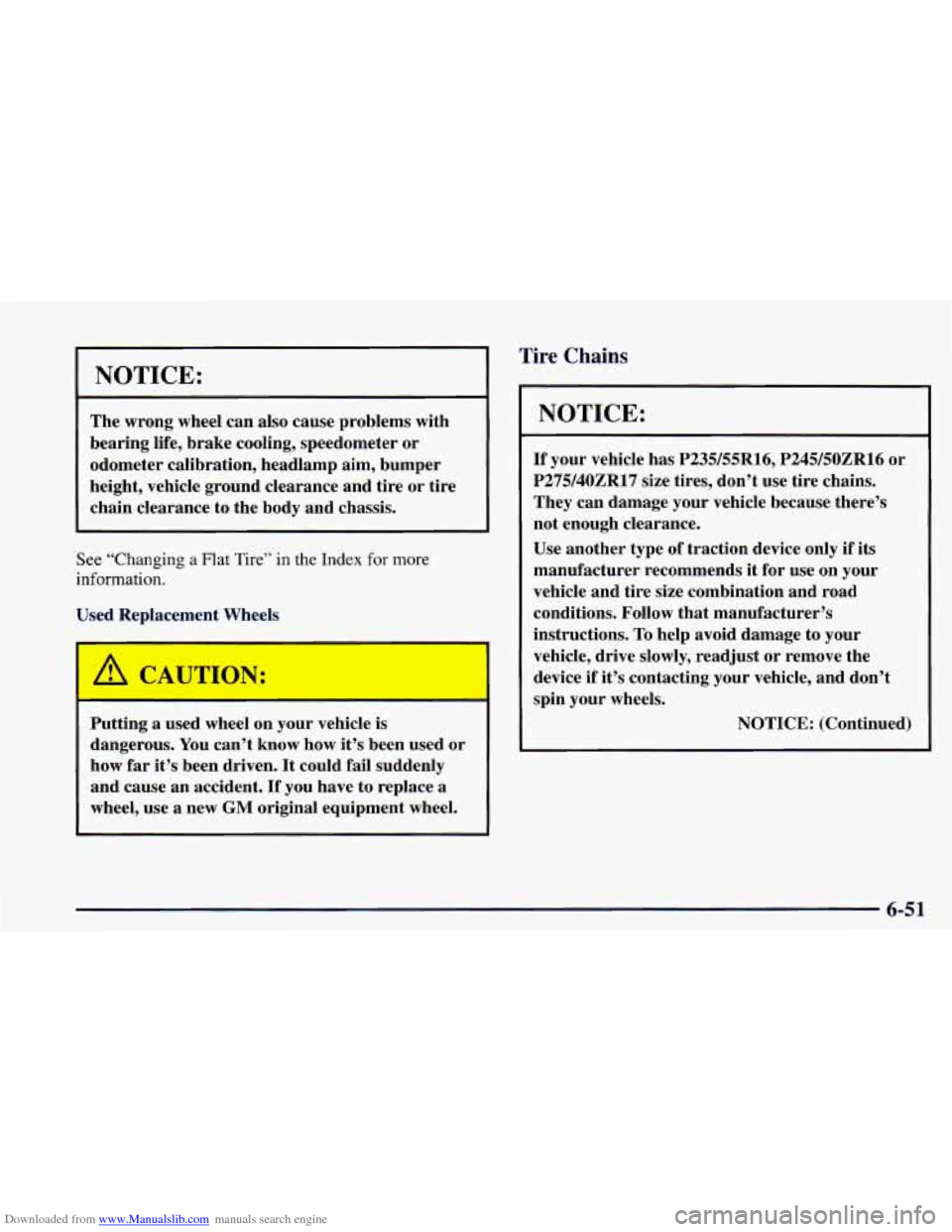
Downloaded from www.Manualslib.com manuals search engine I NOTICE:
~
The wrong wheel can also cause problems with
bearing life, brake cooling, speedometer or
odometer calibration, headlamp aim, bumper
height, vehicle ground clearance and tire or tire
chain clearance to the body and chassis.
See “Changing a Flat Tire” in the Index for more
information.
Putting a used wheel on your vehicle is
dangerous. You can’t know how it’s been used or
how far it’s been driven. It could fail suddenly
and cause an accident.
If you have to replace a
wheel, use a new
GM original equipment wheel.
rire Chains
NOTICE:
If your vehicle has P235/55R16, P245/50ZR16 or
P275/40ZR17 size tires, don’t use tire chains.
They can damage your vehicle because there’s
not enough clearance.
Use another type of traction device only
if its
manufacturer recommends it for use on your
vehicle and tire size combination and road
conditions. Follow that manufacturer’s
instructions.
To help avoid damage to your
vehicle, drive slowly, readjust or remove the
device if it’s contacting your vehicle, and don’t
spin your wheels.
NOTICE: (Continued)
6-51
Page 310 of 402

Downloaded from www.Manualslib.com manuals search engine NOTICE: (Continued)
If you do find traction devices that will fit, install
them on the rear tires.
If you have other tires, use tire chains only where
legal and only when you must. Use only
SAE
Class “S” type chains that are the proper size for
your tires. Install them on the rear tires and
tighten them as tightly as possible with the ends
securely fastened. Drive slowly and follow the
chain manufacturer’s instructions.
If you can
hear the chains contacting your vehicle, stop
and retighten them.
If the contact continues,
slow down until it stops. Driving too fast or
spinning the wheels with chains on will damage
your vehicle.
Appearance Care
Remember, cleaning products can be hazardous. Some
are toxic. Others can burst into flame if
you strike a
match or get them on a hot part
of the vehicle. Some are
dangerous
if you breathe their fumes in a closed space.
When
you use anything from a container to clean your
vehicle, be sure
to follow the manufacturer’s warnings and instructions. And always open your doors or
windows when you’re cleaning the inside.
Never use these to clean your vehicle:
0 Gasoline
0 Benzene
Naphtha
Carbon Tetrachloride
0 Acetone
0 Paint Thinner
0 Turpentine
0 Lacquer Thinner
0 Nail Polish Remover
They can all be hazardous
-- some more than
others
-- and they can all damage your vehicle, too.
Don’t use any of these unless this manual says you can.
In many uses, these will damage your vehicle:
Alcohol
Laundry Soap
0 Bleach
0 Reducing Agents
Page 316 of 402
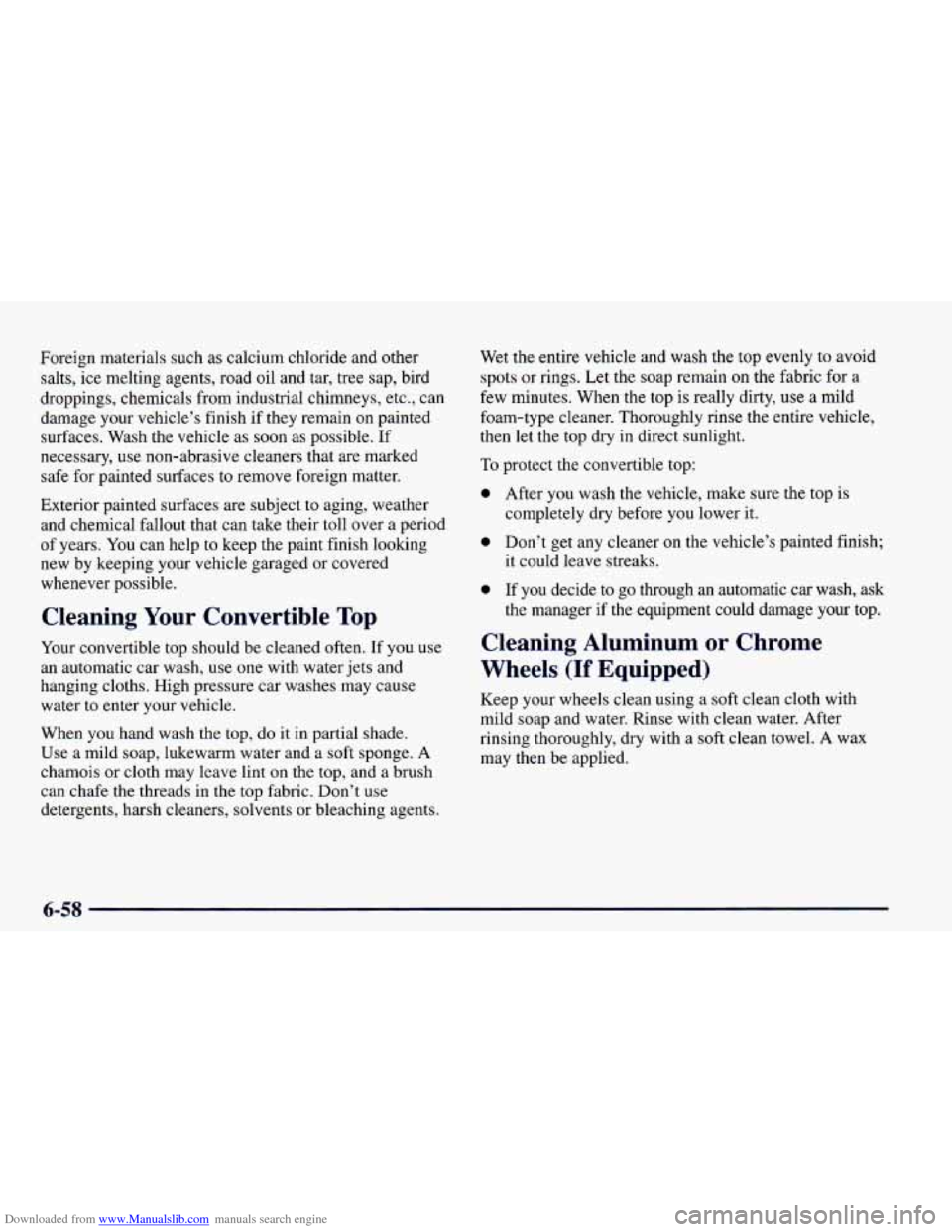
Downloaded from www.Manualslib.com manuals search engine Foreign materials such as calcium chloride and other
salts,
ice melting agents, road oil and tar, tree sap, bird
droppings, chemicals from industrial chimneys, etc., can
damage your vehicle’s finish if they remain on painted
surfaces. Wash the vehicle as
soon as possible. If
necessary, use non-abrasive cleaners that are marked
safe for painted surfaces to remove foreign matter.
Exterior painted surfaces are subject to aging, weather
and chemical fallout that can take their toll over a period
of years. You can help to keep the paint finish looking
new by keeping your vehicle garaged or covered
whenever possible.
Cleaning Your Convertible Top
Your convertible top should be cleaned often. If you use
an automatic car wash, use one with water jets and
hanging cloths. High pressure car washes may cause
water to enter your vehicle.
When you hand wash the top, do it in partial shade.
Use a mild soap, lukewarm water and a soft sponge. A
chamois or cloth may leave lint on the top, and a brush
can chafe the threads
in the top fabric. Don’t use
detergents, harsh cleaners, solvents or bleaching agents. Wet
the entire vehicle and wash the top evenly to avoid
spots or rings. Let the soap remain on the fabric for a
few minutes. When the top is really dirty, use
a mild
foam-type cleaner. Thoroughly rinse the entire vehicle,
then let the top dry in direct sunlight.
To protect the convertible top:
0 After you wash the vehicle, make sure the top is
0 Don’t get any cleaner on the vehicle’s painted finish;
completely dry before
you lower it.
it could leave streaks.
0 If you decide to go through an automatic car wash, ask
the manager if the equipment could damage your top.
Cleaning Aluminum or Chrome
Wheels
(If Equipped)
Keep your wheels clean using a soft clean cloth with
mild soap and water. Rinse with clean water. After
rinsing thoroughly, dry with a soft clean towel. A wax
may then be applied.
6-58
Page 319 of 402
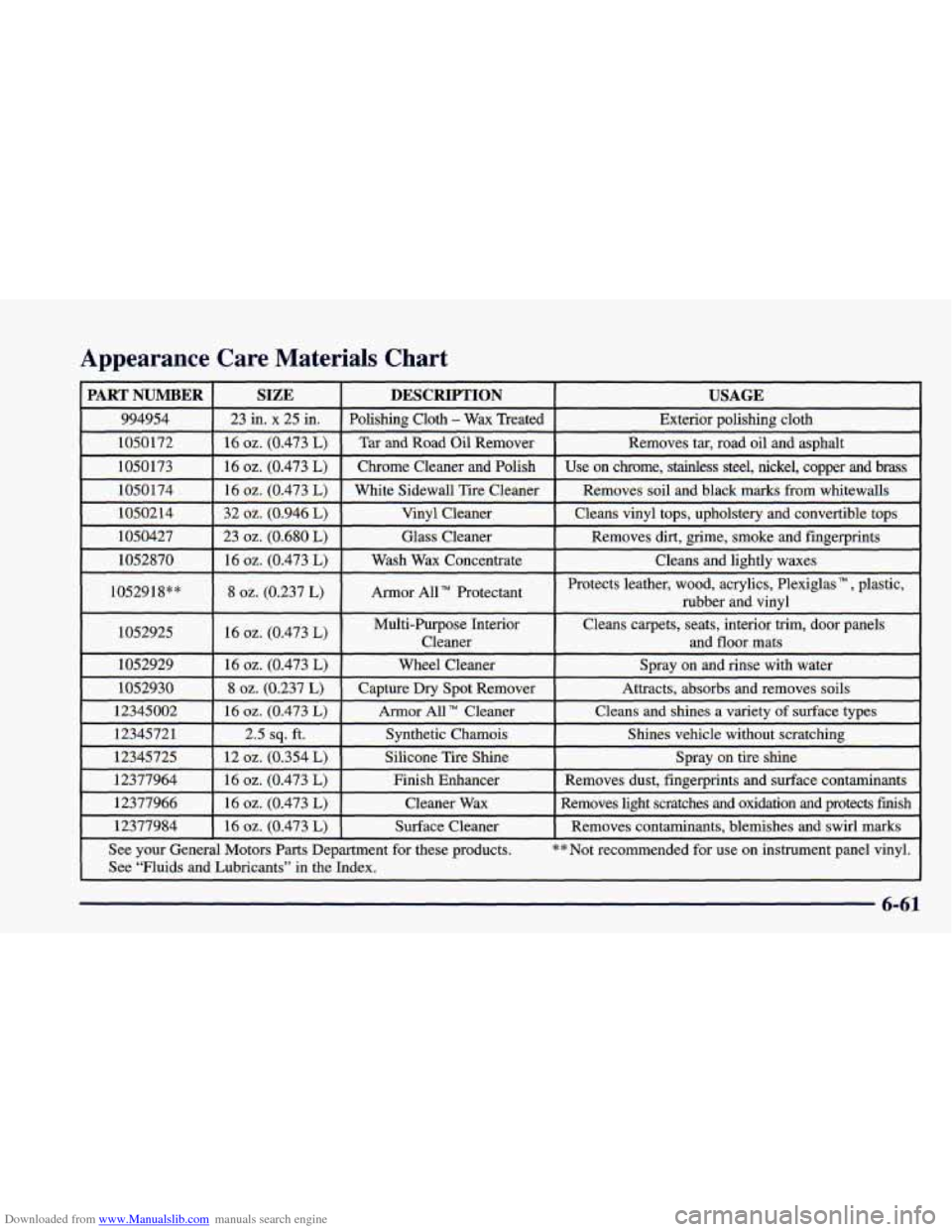
Downloaded from www.Manualslib.com manuals search engine Appearance Care Materials Chart
I 1050172
I 1050173
I 1050174
1052918**
SIZE DESCRIPTION USAGE
23 in. x 25 in. Polishing Cloth - Wax Treated Exterior polishing cloth
1052925
1052929
1052930
12345002
1234572
1
12345725
12377964
12377966
12377984
_____
16 oz. (0.473 L) Tar and Road Oil Remover Removes tar, road oil and asphat
16
oz. (0.473 L) Chrome Cleaner and Polish Use on chrome, stainless steel, nickel, copper and brass
16 oz. (0.473 L) White Sidewall Tire Cleaner Removes soil and black marks from \
whitewalls
32
oz. (0.946 L) Vinyl Cleaner Cleans vinyl tops, uphokeryand convertibletops ~
23 oz. (0.680 L) Glass Cleaner Removes dirt, grime, smoke and fingerprints
16
oz. (0.473 L) Wash Wax Concentrate
~~ _- ~-. ~
Cleans and lightly waxes
8 oz. (0.237 L) Annor All” Protectant I I
Protects leather, wood, acrylics, Plexiglas m, plastic,
rubber and vinyl
16
oz. (0.473 L)
16 oz. (0.473 L) Wheel Cleaner Spray on and rinse with water
Multi-Purpose Interior Cleans carpets, seats, interior trim, door\
panels
Cleaner and floor mats
8 02. (0.237 L) Capture Dry Spot Remover Attracts, absorbs and removes soils
16
oz. (0.473 L) Armor All TM Cleaner Cleans and shines a variety of surface types
2.5
sq. ft. Synthetic Chamois Shines vehicle without scratching
12
oz. (0.354 L) Silicone Tire Shine Spray
on tire shine
16
oz. (0.473 L) Finish Enhancer Removes dust, fingerprints and surface contaminants
16
oz. (0.473 L) Cleaner Wax Removes light scratches and oxidation and protects finish
16
oz. (0.473 L) Surface Cleaner Removes contaminants, blemishes and swirl marks I
See your General Motors Parts Department for these products. **Not recommended for use on instrument panel vinyl.
See “Fluids and Lubricants” in the Index.
-_-
, __.~ - - .- 6-61